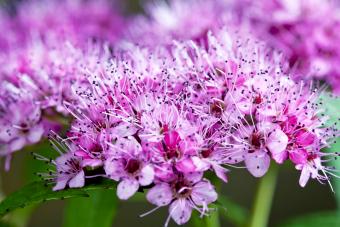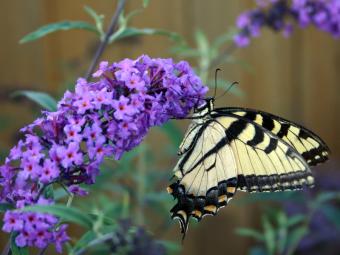
There are almost 100 species in the genus Spiraea, all of which are native to the northern hemisphere. Several have been popular garden shrubs for generations, and many named varieties are equally popular today. These deciduous shrubs are beautiful and easy to grow.
Growing Spiraea in Your Garden
Spirea (Spiraea spp.) is a diverse group of shrubs, useful for hedges, shrub borders, or accent plantings. These blooming shrubs flower in shades of white, pink, yellow, and red, and grow from two to 10 feet tall and wide.

If you are purchasing spirea shrubs for your garden, check the full name of the shrub carefully. Many nurseries use the common name 'spirea' for varieties of Caryopteris, which is a completely different shrub. Don't get the wrong one by mistake!
Spiraea is hardy in Zones 3 through 8.
How to Grow Spirea
Spirea are easy-care shrubs that flower best when grown in full sun. They can be planted in the spring or fall. The new plants should be kept moist while they are getting established, but older shrubs can tolerate dry soil and some drought. In fact, some species of spirea are recommended for water-conserving landscaping.
Pruning Spiraea
The large, arching species usually bloom in the spring, while the smaller, upright species generally bloom in the summer.
- Spring-flowering spirea should be pruned right after they bloom, before new buds start to form for the following year's flowers.
- Summer-flowering spirea should be pruned in late winter or early spring.
Cut old canes back at ground level. Bushes can be rejuvenated by removing one-third of the plant, keeping the youngest and most vigorous canes and removing the oldest.
Propagating Spiraea
Spirea are easily propagated from cuttings of green tip shoots taken in late spring and summer. They root best if given bottom heat. Mature wood cuttings can be taken in autumn and rooted in a cold frame.
Kinds of Spirea
Several different kinds of spirea are grown as garden shrubs. Whether you need a small shrub or a large one suitable for a hedge or shrub border, there's sure to be a variety that fits perfectly in your garden.
Meadowsweet
Meadowsweet (Spiraea alba) is an attractive mound-shaped shrub that grows to about three to six feet fall and wide. The foliage of this shrub is yellowish green, but it turns bright yellow in the fall. It's a summer-blooming shrub that forms conical-shaped clusters of white flowers. This plant, like many spiraeas, is very attractive to pollinators such as bees and butterflies.
Bridal Veil Spirea
This is the shrub that comes to most people's minds when they think of spirea. Your grandparents probably grew bridal veil spirea in their gardens, and you may want to grow it too. Spiraea x vanhouttei is commonly called 'bridal veil spirea', but Spiraea prunifolia is also known by that name.

These are large bushes, growing up to ten feet tall and sometimes as much as twenty feet wide. Their arching branches are laden with tiny white flowers in the spring. Seeing a hedge of bridal veil spirea will take your breath away! Spiraea cantoniensis, commonly called Reeves Spirea, is a double-flowered white bridal veil. It is a smaller shrub, and in warm climates it may keep its leaves through the winter.
Baby's Breath Spirea
Spiraea thunbergii is also called thunberg spirea or garland spirea. This is a graceful shrub with slender, arching branches that grows three to five feet tall with a similar spread. The shrub has an almost feathery appearance, making it valuable as a foliage plant. The small leaves turn orange in the fall. It blooms profusely in late winter or early spring, before the new leaves appear.

This species is native to China and Japan. It blooms best in full sun, and bloom is heaviest in cool climates, where the small white flowers can cover the entire shrub. In warm climates, the bloom is less intense but lasts for a longer time. Baby's breath spirea can be propagated by dividing the root clump, unlike some other species.
Japanese Spirea
Several cultivars from Spiraea japonica are grown as garden plants. These are upright shrubs growing two to six feet tall. They bloom in summer. The flowers are white, pink, or red; the 'Shirobana' variety has all three colors at once. Some varieties have yellow or purple foliage.

Bumalda Spireas
Spiraea x bumalda is a cross between S. albiflora and S. japonica. These are low-growing shrubs, two to three feet tall with a slightly wider spread. Some varieties have yellow foliage. Burmalda spirea bloom in the summer. The flowers are pink or white depending on the variety. S. x bumalda 'Anthony Waterer' is the best known variety.

What to Plant With Spiraea
Spiraea is such a versatile family of plants, and there are so many plants (shrubs, annuals, perennials, and ground covers alike) that grow well with it. Consider combining spiraea with some of these plants:
Spiraea for Carefree Beauty
Spiraea are easy to grow, beloved by bees and butterflies, and provide a solid three seasons of interest in your garden. Because you can find varieties in a range of sizes, foliage colors, and shades of blooms, chances are good that you can find one to fit perfectly in your landscape.







